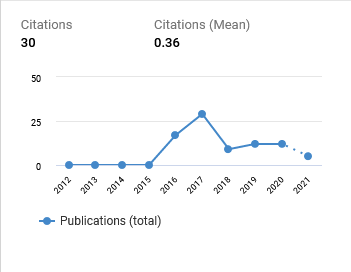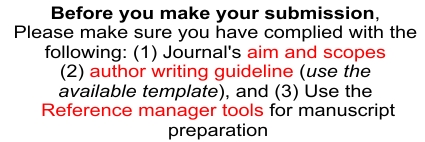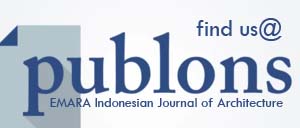Eventual Space Invasion Concept: The Flexible Use of Low-Cost Flat Building Design
DOI:
https://doi.org/10.29080/eija.v7i1.1187Keywords:
invasi ruang, ruang fleksibel, eventual spaceAbstract
Spatial invasion is a subjective expression of low-income communities in the riverbank areas. This lifestyle is one of the expressions of society to meet the lack of spatial space in residential areas, especially in riverbank areas. The previous study stated several things, the invasion of the lifestyle of the riverside community has occurred especially when the settlements were divided spatially. Besides, the precedent for the rusunawa in Surabaya shows its design by providing spaces that connected spaces, units, and buildings, which are usually invaded by the inhabitants for domestic and social activities. Qualitative studies were obtained to find the configuration of spatial invasion through activity observations and in-depth interviews with several participants living in riverbank settlements. This study analyses whether the use of space in the flat can be designed under similar activities and the use of spatial intervention in the kampung settlement, in this context near the river border. The results showed that there were similarities in the use of public spaces in residential areas and rusunawa, namely eventual space invasion that is used as the design concept. Shared space for community activities in the settlements can be adopted and provided in flat design with the support of several architectural elements. These expressions are then simulated into several concept illustrations of a flat design proposal with several required conditions. The result proposes several potentials of space in the flat that can be used for domestic and social interests.
Downloads
References
Baum, A., Riess, M., & O’hara, J. (1974). Architectural variants of reaction to spatial invasion: Environment and behavior. Environment and Behavior, 6(1), 125–125. https://doi.org/10.1177/001391657400600113
Bebi. (2019). Rusunawa Sombo Kumuh, Risma Ambil Cat, Sapu lalu Lakukan ini Bersama Para S. Surabayapagi.Com. https://surabayapagi.com/read/rusunawa-sombo-kumuh--risma-ambil-cat--sapu-lalu-lakukan-ini-bersama-para-stafnya
Ćetković, A. (2012). Flexibility in architecture and its relevance for the ubiquitous house. Technoetic Arts, 10(2–3), 213–219. https://doi.org/10.1386/tear.10.2-3.213_1
Creswell, J. W. (2014). Research Design: Qualitative, Quantitative, and Mixed Methods Approaches (4th ed). SAGE.
Das, A. (2015). Slum upgrading with community-managed microfinance: Towards progressive planning in Indonesia. Habitat International, 47, 256–266. https://doi.org/10.1016/j.habitatint.2015.01.004
Das, A. (2017). A City of Two Tales: Shelter and Migrants in Surabaya. Environment and Urbanization ASIA, 8(1), 1–21. https://doi.org/10.1177/0975425316686501
Ernawati, R. (2019). Faktor yang Mempengaruhi Kepuasan Tinggal pada Rusunawa di Kota Surabaya. Emara: Indonesian Journal of Architecture, 5(1), 24–31. https://doi.org/10.29080/eija.v5i1.527
Frick, H., & Mulyani, T. H. (2006). Arsitektur ekologis: Konsep arsitektur ekologis pada iklim tropis, penghijauan dan kota ekologis, serta energi terbarukan OPAC Perpustakaan Nasional RI. Penerbit Kanisius. https://opac.perpusnas.go.id/DetailOpac.aspx?id=536367
Haryadi. (2010). Arsitektur, lingkungan, dan perilaku: Pengantar ke teori, metodologi, dan aplikasi. Gadjah mada University Press.
Hutagalung, A. s. (2007). Dinamika pengaturan rumah susun atau apartemen. Jurnal Hukum & Pembangunan, 34(4), 317–330. https://doi.org/10.21143/jhp.vol34.no4.1443
Jormakka, K., Schürer, O., & Kuhlmann, D. (2014). Basics Design Methods. Walter de Gruyter GmbH.
KBBI. (n.d.). Definisi Invasi. Retrieved 27 December 2021, from https://kbbi.kemdikbud.go.id/entri/invasi
Kisnarini, R. (2015). Functionality and adaptability of low cost apartment space design: A case of Surabaya Indonesia. Technische Universiteit Eindhoven.
Kopec, D. (2018). Environmental Psychology for Design. Bloomsbury Academic.
Kronenburg, D. (2007). Flexible: Architecture that Responds to Change. Laurence King Publishing.
Lianto, F., & Dwisusanto, B. (2015). Teritorialitas dan keamanan penghuni pada permukiman horisontal dan vertikal (rumah susun sederhana), [studi kasus: Rumah susun sederhana sewa (rusunawa) bumi cengkareng indah, jakarta]. Jurnal Sosial Ekonomi Pekerjaan Umum, 7(3), 219–228.
Maslow, A. H. (2010). Toward A Psychology of Being-Reprint of 1962 Edition First Edition. Martino Publishing.
Pemkot Sutrabaya. (2017). Visi Misi Walikota RPJMD 2016—2021. https://surabaya.go.id/id/page/0/37273/visi-misi-walikota-rpjmd-2016-----2021
Plomp, T. (2007). Educational Design Research: An Introduction. Seminar on ‘Educational Design Research’, China.
Plowright, P. D. (2014). Revealing Architectural Design: Methods, Frameworks and Tools. Routledge.
Prasetyo, S. (2017). Suka-Duka Urus Administrasi Penghuni Rusun, Pengaduan Cepat tapi Bayar Lelet. Jawapos.Com. https://www.jawapos.com/metro/metropolis/07/01/2017/suka-duka-urus-administrasi-penghuni-rusun-pengaduan-cepat-tapi-bayar-lelet/
Ramadhani, A. N., Faqih, M., & Hayati, A. (2017). Behaviour Setting and Spatial Usage Analysis on Sombo Low Cost Flat’s Corridor. Journal of Architecture & Environment, 16(1), 61–74. https://doi.org/10.12962/j2355262x.v16i1.a3189
Ramadhani, A. N., Hayati, A., & Faqih, M. (2019). The Effect of Physical Quality Improvement to Inhabitant’s Sense of Place. EMARA: Indonesian Journal of Architecture, 5(1), 32–40. https://doi.org/10.29080/eija.v5i1.656
Supratini, D. A. (2019). Waduh! Ratusan Penghuni Rusunawa Tak Mau Bayar Uang Sewa. Info SUrabaya. https://infosurabaya.id/2019/01/09/waduh-ratusan-penghuni-rusunawa-tak-mau-bayar-uang-sewa/
Wastara, J. G. (2020). Fleksibilitas ruang sosial: Perancangan hunian kolektif dengan gaya hidup sempadan sungai [Masters Thesis, Institut Teknologi Sepuluh Nopember]. https://repository.its.ac.id/79850/
Zahro, F. (2017). Banyak Bangunan Liar di Rusun Sombo, ini yang Akan Dilakukan Pemkot Surabay. https://surabaya.tribunnews.com/2017/08/27/banyak-bangunan-liar-di-rusun-sombo-ini-yang-akan-dilakukan-pemkot-surabaya.

Downloads
Published
How to Cite
License
Copyright (c) 2021 Joshua Gama Wastara, Arina Hayati

This work is licensed under a Creative Commons Attribution-ShareAlike 4.0 International License.
- Authors retain copyright and grant the journal right of first publication with the work simultaneously licensed under a Creative Commons Attribution ShareAlike License that allows others to share the work with an acknowledgment of the work's authorship and initial publication in this journal.
- Authors are able to enter into separate, additional contractual arrangements for the non-exclusive distribution of the journal's published version of the work (e.g., post it to an institutional repository or publish it in a book), with an acknowledgment of its initial publication in this journal.
- Authors are permitted and encouraged to post their work online (e.g., in institutional repositories, pre-print sites, or on their website) prior to and during the submission process, as it can lead to productive exchanges, as well as earlier and greater dissemination of published work.
































